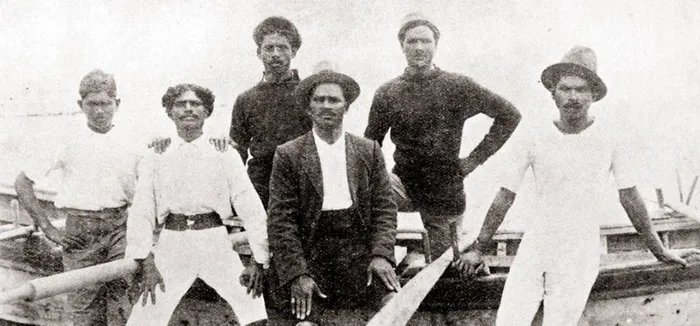Padavatan brothers' heroism remembered on 108th anniversary of Umgeni floods
Bravery

Back from left: Sabapathy Periyasamy Govender and Captain Mariemuthoo Padavatan. Front from left: Kuppusamy Naidoo, T Veloo, Gangan Padavatan and Rangasamy Naidoo.
Image: Supplied
TODAY marks the 108th anniversary of the Padavatan brothers - the heroes of the Umgeni Floods of October 28, 1917. The brothers had saved 175 lives.
Despite our vast disparities and conflicts, history has always shown that humankind has an inordinate ability to work together in our darkest hours.
Viroshen Chetty and Neelan Govender wonderfully reveal this magnanimity of spiritedness in The Legends of the Tide. This beautifully scripted book is an ode to the fisher-folk community in Durban. This precious book is one of a few resources that chronicle the many untold stories of South Africa’s fractured past some 25 years into our democracy.
Of particular relevance to this column is the detailed account of the devastating floods of 1917 found in the book, Legends of the Tide.
On October 28, 1917, more than 400 market gardeners of indentured ancestry from the Springfield Flats (Tin Town) area in Durban drowned when the banks of the Umgeni (uMngeni) River burst after unprecedented heavy rains. The death toll would have been much higher, had it not been for the bravery of six seine-netters who saved some 176 people from drowning.
These six brave seine netters, Mariemuthoo Padavatan, Gengan Padavatan, T Veloo, Sabapathy Govender, Rungasamy Naidoo and Kuppusamy Naidoo became known as the Padavatan Six heroes.
The rescue effort of the Padavatan Six is considered as one of the largest civilian acts of bravery in South Africa. The fishermen made five trips into the raging river in an oar-driven banana boat that they had used for their everyday fishing.
The Padavatan Six were named after their captain, Mariemuthoo Padavatan, one of the leaders of a small community of generational seine-netters who lived and worked on the beaches of Durban. On the day of the floods, Padavatan was checking on his boats at Addington Beach, fearing that they may have be destroyed by the storm, when some of his workers arrived on a speeding fire-truck stating that the Borough Police Chief, one Inspector Alexander, needed boats, ropes and volunteers because Tin Town was flooding.
Dr Neelan Govender, the co author of Legends of the Tide and son of Sabapathy Periyasamy Govender (a member of the Padavatan Six), recalls: “My father, Sabapathy, recounted the rescue mission with indescribable sadness. He remembered a family perched on a precarious rooftop. Even before they could reach this family, the young mother with her child clutched tight in her arms, slid off the roof with a heart-rending shriek. She and the child disappeared under the swirling waters and were swept away in the strong current.
"One of the saddest stories to emerge was that of a man who lost 14 members of his immediate family. His wife, children and other members of his family were all swept away by the waters, and he himself was almost buried in mud before he was rescued. He had one of his children on his shoulders that later died through exposure.”
On December 8, 1917, the City of Durban paid tribute to the Padavatan Six in a public ceremony. They were given gold medals and their captain, Mariemuthoo Padavatan, was awarded a gold walking stick and a watch.
The M Padavatan Primary School in Chatsworth was later named in memory of Mariemuthoo Padavatan, captain of the rescue mission.
Selvan Naidoo is the director of the 1860 Heritage Centre.